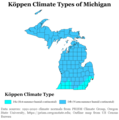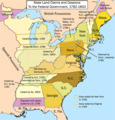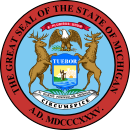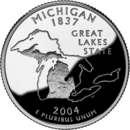The Michigan Portal  Michigan (/ˈmɪʃɪɡən/ ⓘ MISH-ig-ən) is a state in the Great Lakes region of the Upper Midwestern United States. It borders Wisconsin to the northwest in the Upper Peninsula, and Indiana and Ohio to the south in the Lower Peninsula; it is also connected by Lakes Superior, Michigan, Huron, and Erie to Minnesota and Illinois, and the Canadian province of Ontario. With a population of nearly 10.12 million and an area of 96,716 sq mi (250,490 km2), Michigan is the 10th-largest state by population, the 11th-largest by area, and the largest by area east of the Mississippi River. Its capital is Lansing, and its largest city is Detroit. Metro Detroit is among the nation's most populous and largest metropolitan economies. The name derives from a gallicized variant of the original Ojibwe word ᒥᓯᑲᒥ (mishigami), meaning "large water" or "large lake". Michigan consists of two peninsulas. The Lower Peninsula resembles the shape of a mitten, and comprises a majority of the state's land area. The Upper Peninsula (often called "the U.P.") is separated from the Lower Peninsula by the Straits of Mackinac, a five-mile (8 km) channel that joins Lake Huron to Lake Michigan. The Mackinac Bridge connects the peninsulas. Michigan has the longest freshwater coastline of any political subdivision in the United States, being bordered by four of the five Great Lakes and Lake St. Clair. It also has 64,980 inland lakes and ponds. Michigan has the second-most water area of any state, behind only Alaska. The area was first occupied by a succession of Native American tribes over thousands of years. In the 17th century, French explorers claimed it as part of the New France colony, when it was largely inhabited by indigenous peoples. French and Canadian traders and settlers, Métis, and others migrated to the area, settling largely along the waterways. After France's defeat in the French and Indian War in 1762, the region came under British rule. Britain ceded the territory to the newly independent United States after its defeat in the American Revolutionary War. The area was part of the larger Northwest Territory until 1800, when western Michigan became part of the Indiana Territory. Michigan Territory was formed in 1805, but some of the northern border with Canada was not agreed upon until after the War of 1812. Michigan was admitted into the Union in 1837 as the 26th state, a free one. It soon became an important center of industry and trade in the Great Lakes region, attracting immigrants in the late 19th and early 20th centuries from many European countries. Immigrants from Finland, Macedonia, and the Netherlands were especially numerous. Migration from Appalachia and of Black Southerners as part of the Great Migration increased in the 1930s, with many settling in Metro Detroit. (Full article...) Entries here consist of Good and Featured articles, which meet a core set of high editorial standards.
 The 2007 Appalachian State vs. Michigan football game was a regular season college football game between the Appalachian State Mountaineers and Michigan Wolverines. It was held at Michigan Stadium in Ann Arbor on September 1, 2007, and was the first game of the season for both teams. The Wolverines entered the game ranked No. 5 in both major Football Bowl Subdivision (FBS) polls and media outlets considered them to be preseason favorites to win the Big Ten conference championship as well as possible contenders for the national championship, while the Mountaineers were ranked No. 1 in The Sports Network's Football Championship Subdivision (FCS) poll and were preseason favorites to win their third consecutive FCS national championship. Games between FBS and FCS teams typically result in lopsided victories for the FBS team, and the Appalachian State–Michigan game was not expected to be an exception. So confident were Las Vegas sportsbooks in Michigan's chances that no betting line was issued for the game. The game was also the first to be broadcast on the then-new Big Ten Network. It began with a strong first half for Appalachian State, who held a 28–17 lead at the end of the half. Michigan regained the lead at 32–31 in the fourth quarter, but Appalachian State took the lead for a second time on a short field goal with 26 seconds left. The Mountaineers blocked a game-winning field goal attempt from Michigan at the end of regulation to secure a 34–32 win. (Full article...)Selected picture - The Grand Hotel is a historic lodging facility located on Mackinac Island, Michigan, a small island located at the eastern end of the Straits of Mackinac within Lake Huron between the state's Upper and Lower Peninsulas. Did you know -
Related portalsSelected article - Detroit, the largest city in the state of Michigan, was settled in 1701 by French colonists. It is the first European settlement above tidewater in North America. Founded as a New France fur trading post, it began to expand during the 19th century with U.S. settlement around the Great Lakes. By 1920, based on the booming auto industry and immigration, it became a world-class industrial powerhouse and the fourth-largest city in the United States. It held that standing through the mid-20th century. The first Europeans to settle in Detroit were French country traders and colonists from the New Orleans (the La Louisiane) colony. They were joined by traders from Montreal and Quebec; all had to contend with the powerful Five Nations of the League of the Iroquois (Haudenosaunee), who took control of the southern shores of Lakes Erie and Huron through the Beaver Wars of the 17th century. Also present and powerful, but further to the north, were the Council of Three Fires (Anishinaabe). (in Anishinaabe: Niswi-mishkodewinan, also known as the People of the Three Fires; the Three Fires Confederacy; or the United Nations of Chippewa, Ottawa, and Potawatomi Indians) is a long-standing Anishinaabe alliance of the Ojibwe (or Chippewa), Odawa (or Ottawa), and Potawatomi North American Native tribes. The Three Fires Confederacy (Anishinaabe) were often supported by the French, while the so-called League of Iroquois, or Five Nations (Haudenosaunee) was supported by the English and Dutch. (Full article...)Selected biography -Eber Brock Ward (December 25, 1811 – January 2, 1875) was an American industrialist, iron and steel manufacturer, and shipbuilder. Ward invested in several industries in Michigan and the Midwest. He started as an owner of steamship interests, and later accumulated woodlands, as well as lands that contained iron ore, copper and silver. His investments would ultimately include newspapers, railroads, glass manufacturing, banking, and insurance companies. (Full article...)General imagesThe following are images from various Michigan-related articles on Wikipedia.
TopicsCategoriesSymbols
Lists
Related pagesWikimediaThe following Wikimedia Foundation sister projects provide more on this subject:
Things you can doDiscover Wikipedia using portals
Purge server cache
| ||||||||||||||||||||||||||||||||||||

Sons of Union Veterans of the Civil War









































































